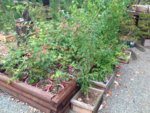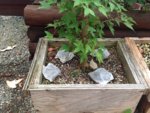What is the point of wiring such a young seedling?
Movement in the trunk low down that allows cutback, change of direction for taper development. Grow the trunk first for maples then branches, Trunks grow faster from sacrifice leader growth, rather than side branch thickness. this only changes if the side branch becomes the new leader. This thread contains a lot of misinformation supplied by people who have obviously not grown maples for any length of time. Unfair to those seeking help!
1. let the maples grow in larger containers or the ground.
2. Work the roots to improve nebari each year for the first three or four years to set the pattern.
3. Let it grow for the full season each year for three to five years and cut back early spring. They will grow 6-8 feet each year.
4. If you do decide to keep some side branches during this process then prune them to keep them from getting to thick.
5. For a guideline you could start with the following suggestion. year one cut back to 3 inches above nebari.
year two cut back to six inches above nebari, year three cut back to 9 inches above nebari. Obviously this is just a starting suggestion and each grower will decide what works for the style and size of tree desired.
For example if a broom is desired then the tree may be supported to grow perfectly straight and only cut when the base has reached the desired thickness. This may mean letting it grow for five years without cutting back in a major way.
The methods vary based on the desired outcome, but the principles of growth, development and refinement remain the same.
Proper growth requires developing a proper rootball in the right conditions. Correct pruning techniques will produce the desired results.



